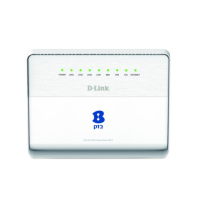
Do you have a question about the D-Link DSL-225 and is the answer not in the manual?
| Wireless Standards | IEEE 802.11b/g/n |
|---|---|
| Wireless Speed | Up to 300 Mbps |
| Antenna | 2 x External Antennas |
| Device Type | Wireless router |
| DSL Standards | ANSI T1.413 Issue 2, ITU G.992.1 (G.dmt), ITU G.992.2 (G.lite), ITU G.992.3 |
| Security | WEP, WPA/WPA2 |
| Firewall | NAT, SPI |
| Ports | 1 x RJ-11 DSL port |
| Security Features | MAC filtering, URL filtering, DoS protection |
| Standards Compliance | IEEE 802.11b/g/n |
| Ethernet Ports | 4 x 10/100 LAN Ports |
Lists all items included in the router's packaging for user verification.
Details the necessary hardware and software for successful router installation and operation.
Highlights high-speed 2.4GHz wireless capabilities and compatibility with various standards.
Covers DHCP, NAT, traffic shaping, and SNMP for network management.
Explains the meaning and status of each LED on the router's front panel.
Details the function of ports and buttons located on the router's rear panel.
Describes the features and ports found on the router's side panel.
Outlines preparation, prerequisites, and important installation notes before setup.
Lists essential details needed from the VDSL provider and for the local network.
Guides on connecting cables, powering on, and utilizing the reset button.
Explains how to establish VDSL and Ethernet connections for the router.
Provides step-by-step instructions to connect to and log into the router's web configuration utility.
Introduces the Setup category and its main configuration pages.
Details how to configure various WAN connectivity services and interfaces.
Guides on configuring ATM interfaces, including adding and removing them.
Explains the process of configuring PTM interfaces for WAN connections.
Covers the detailed configuration steps for PPPoE WAN connections.
Details the configuration for IP over Ethernet WAN service types.
Covers PPP username, password, service name, and authentication methods.
Guides on setting up default gateways and static routes for network traffic.
Explains how to configure DNS servers for domain name resolution.
Details settings for the router's 2.4GHz wireless network.
Covers IP address, subnet mask, and IGMP snooping for the LAN.
Guides on configuring IPv6 connectivity and related LAN applications.
Details setting the router's time, date, and time zone for accurate logging.
Provides advanced configuration for wireless features like channel, security, and QoS.
Configures rules to allow external access to specific ports and services.
Covers DMZ host setup and features for restricting internet access.
Details setting up inbound, outbound, and bridge IP filtering rules.
Explains DNS server settings and dynamic DNS hostname configuration.
Accesses tools for queue management, QoS classification, UPnP, and DSL settings.
Covers static routes, default gateway management, and RIP protocol settings.
Guides on setting up IPv6-in-IPv4 and DS-Lite tunnels for network connectivity.
Details settings for enabling the onboard print server and Samba file sharing.
Covers backup, restore, factory reset, and system reboot functions.
Explains the process for updating the router's firmware to the latest version.
Guides on changing login credentials and enabling remote access to the router.
Details how to run diagnostic tests and manage system event logs.
Displays system information and a list of current DHCP clients.
Provides statistical data for LAN, WAN, xTM, and xDSL interfaces.
Displays routing table information and details about WAN interfaces.
Shows information related to Address Resolution Protocol (ARP) interfaces.
Explains basic networking concepts like IP addresses and DHCP server operation.
Covers what wireless is, how it works, WLAN, and WPAN technologies.
Details WPA, WPA2, and security modes for securing wireless networks.
Addresses common user issues and provides troubleshooting solutions.
Lists hardware details, voltage, operating temperature, and humidity.
Details ADSL/VDSL standards, wireless frequencies, and bandwidth rates.
Provides product certifications (e.g., CE) and physical dimensions.